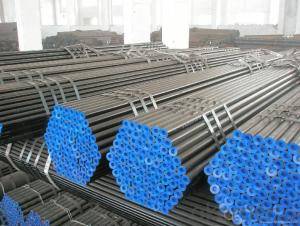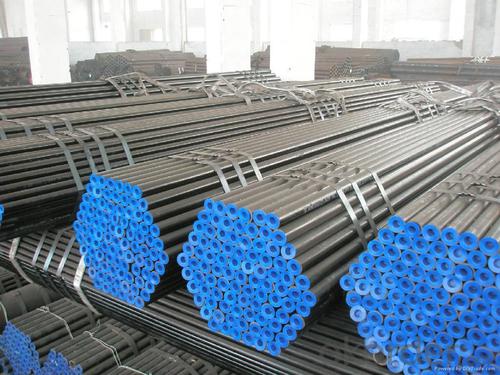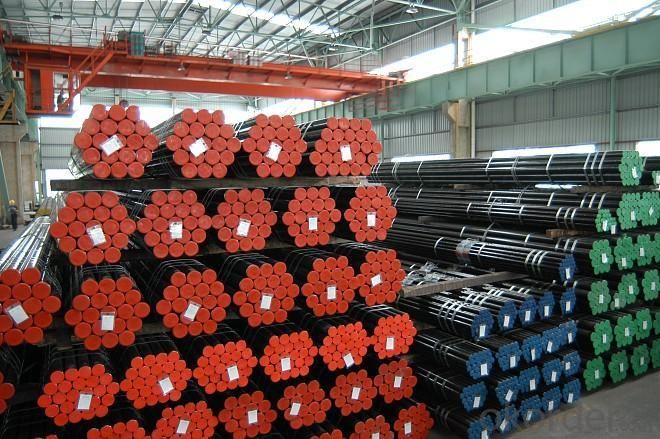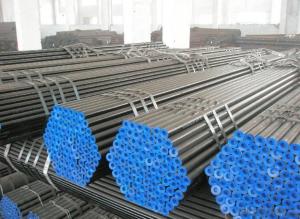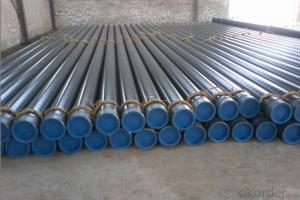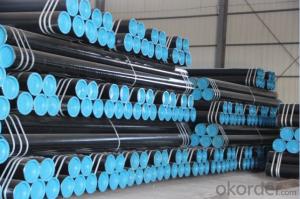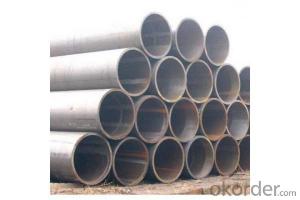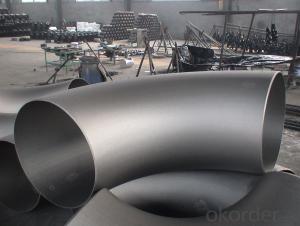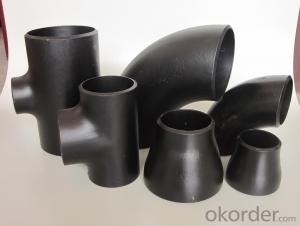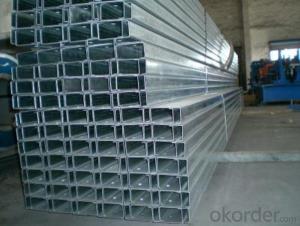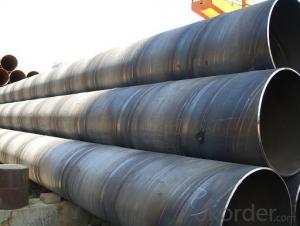Carbon Steel Line Pipes with Various Standard
- Loading Port:
- Tianjin
- Payment Terms:
- TT OR LC
- Min Order Qty:
- 25 m.t.
- Supply Capability:
- 10000 m.t./month
OKorder Service Pledge
OKorder Financial Service
You Might Also Like
1、Structure of Carbon Steel Line Pipes with Various Standard:
Seamless pipe is formed by drawing a solid billet over a piercing rod to create the hollow shell. As the manufacturing process does not include any welding, seamless pipes are perceived to be stronger and more reliable. Historically seamless pipe was regarded as withstanding pressure better than other types, and was often more easily available than welded pipe.
2、Main Features of the Carbon Steel Line Pipes with Various Standard:
• High manufacturing accuracy
• High strength
• Small inertia resistance
• Strong heat dissipation ability
• Good visual effect
• Reasonable price
3、Carbon Steel Line Pipes with Various Standard Specification:
Standard | GB, DIN, ASTM ASTM A106-2006, ASTM A53-2007 |
Grade | 10#-45#, 16Mn 10#, 20#, 45#, 16Mn |
Thickness | 8 - 33 mm |
Section Shape | Round |
Outer Diameter | 133 - 219 mm |
Place of Origin | Shandong, China (Mainland) |
Secondary Or Not | Non-secondary |
Application | Hydraulic Pipe |
Technique | Cold Drawn |
Certification | API |
Surface Treatment | factory state or painted black |
Special Pipe | API Pipe |
Alloy Or Not | Non-alloy |
Length | 5-12M |
Outer Diameter | 21.3-610mm |
Grade | 20#, 45#, Q345, API J55, API K55, API L80, API N80, API P110, A53B |
Standard | ASME, ASTM |
1) Material:20#(ASTM A 106/A53 GRB.API5LGRB,GB),45#,16Mn,10#.
2) Specification range:OD:21.3-610mm,WT:6-70mm,length:6-12m or according to the requirement of clients.
3) Excutive standards:GB,ASME API5L.ASTM A 106/A53,Despite of the above standards,we can also supply seamless steel pipe with standard of DIN,JIS,and so on,and also develop new products according to the requirements of our clients!
4) Surface:black lacquered,varnish coating or galvanized.
5) Ends:Beveled or square cut,plastic capped,painted.
6) Packing:bundles wrapped with strong steel strip,seaworthy packing.
4、Packaging & Delivery
Packaging Details: | seaworthy package,bundles wrapped with strong steel strip |
Delivery Detail: | 15-30days after received 30%TT |
5、FAQ of Carbon Steel Line Pipes with Various Standard:
①How is the quality of your products?
Our products are manufactured strictly according to national and internaional standard, and we take a test
on every pipe before delivered out. If you want see our quality certifications and all kinds of testing report, please just ask us for it.
Guaranteed: If products’ quality don’t accord to discription as we give or the promise before you place order, we promise 100% refund.
②How about price?
Yes, we are factory and be able to give you lowest price below market one, and we have a policy that “ for saving time and absolutely honest business attitude, we quote as lowest as possible for any customer, and discount can be given according to quantity”,if you like bargain and factory price is not low enough as you think, just don’t waste your time.Please trust the quotation we would give you, it is professional one.
③Why should you chose us?
Chose happens because of quality, then price, We can give you both.Additionally, we can also offer professional products inquiry, products knowledge train(for agents), smooth goods delivery, exellent customer solution proposals.Our service formula: good quality+good price+good service=customer’s trust
SGS test is available, customer inspection before shipping is welcome, third party inspection is no problem
- Q: How are steel pipes used in the construction of dams and water reservoirs?
- Steel pipes are commonly used in the construction of dams and water reservoirs due to their durability, strength, and ability to withstand high pressure and heavy loads. These pipes are utilized in various important aspects of dam and reservoir construction. One of the main uses of steel pipes in these structures is for the transportation of water. Steel pipes are used to convey water from the source, such as a river or stream, to the reservoir or dam. These pipes are designed to withstand the high water pressure and ensure that there is a continuous flow of water to the reservoir. The durability of steel pipes allows them to remain intact even in harsh conditions and environments. In addition to transporting water, steel pipes are also used for drainage purposes. They are used to create drainage systems that help regulate the water level in the reservoir or dam. These pipes are strategically placed to control the flow of water and prevent any potential flooding or overflow. Steel pipes are also used in the construction of the spillways and outlets in dams and reservoirs. Spillways are designed to release excess water from the reservoir during heavy rainfall or when the water level is too high. Steel pipes are used in the construction of these spillways to provide a controlled path for the water to flow out of the reservoir, preventing any damage to the dam or surrounding areas. Furthermore, steel pipes are utilized in the construction of penstocks, which are large pipes that transport water from the reservoir to the turbines in a hydropower plant. The pressure generated by the water in these pipes is used to drive the turbines and generate electricity. The strength and durability of steel pipes are crucial for ensuring the smooth and efficient operation of hydropower plants. Overall, steel pipes play a vital role in the construction of dams and water reservoirs. Their durability, strength, and ability to withstand high pressure make them an ideal choice for various aspects of these structures, including water transportation, drainage systems, spillways, and penstocks.
- Q: Can steel pipes be used in extremely cold temperatures?
- Yes, steel pipes can be used in extremely cold temperatures. Steel is known for its strength and durability, making it suitable for various applications, including in extreme cold weather conditions. Steel pipes have a high resistance to low temperatures and can withstand the effects of freezing temperatures without losing their structural integrity. This makes them ideal for use in industries such as oil and gas, where they are exposed to sub-zero temperatures. Additionally, steel pipes can be insulated or coated to provide further protection against the cold and prevent any potential issues, such as freezing or cracking. Overall, steel pipes are a reliable choice for use in extremely cold temperatures.
- Q: How are steel pipes used in natural gas processing plants?
- Steel pipes are used extensively in natural gas processing plants for various purposes, including the transportation of natural gas, the transfer of various fluids, and the construction of pipelines and infrastructure. These pipes are highly durable, resistant to corrosion, and can withstand high pressure, making them ideal for safely transporting natural gas and other substances throughout the facility.
- Q: How are steel pipes used in irrigation systems?
- Steel pipes are commonly used in irrigation systems as they offer durability, strength, and corrosion resistance. These pipes are used to transport water from a water source to the fields or crops being irrigated. Their smooth interior surface allows for efficient water flow, and their high-pressure rating ensures that water reaches the desired areas with adequate force. Additionally, steel pipes are often used in underground irrigation systems due to their ability to withstand external pressures and protect the water supply from potential damage.
- Q: How do steel pipes compare to other materials like PVC or copper?
- Steel pipes have several advantages over other materials like PVC or copper. Firstly, steel pipes are incredibly strong and durable. They can withstand high pressure and extreme temperatures without cracking or bending. This makes them ideal for heavy-duty applications such as industrial piping systems or underground installations. Secondly, steel pipes have excellent corrosion resistance. Unlike copper pipes that can corrode over time, steel pipes are typically coated with anti-corrosive materials such as zinc or epoxy. This protective layer prevents rust and ensures a longer lifespan for the pipes. Furthermore, steel pipes offer superior fire resistance compared to PVC or copper. They are non-combustible and can withstand high temperatures for extended periods without deforming or releasing toxic gases. This makes steel pipes a safer option for applications where fire hazards are a concern. In terms of cost, steel pipes may be more expensive than PVC initially, but they offer better long-term value due to their durability and longevity. Copper pipes, on the other hand, can be quite expensive and are susceptible to theft due to their scrap value. Lastly, steel pipes are highly versatile and can be used in various applications, including water supply, sewage systems, gas pipelines, and oil refineries. They can handle high volumes of fluid with ease and are resistant to external factors like UV rays or physical impacts. Overall, steel pipes are a reliable and efficient choice for many industries and applications, offering strength, durability, corrosion resistance, fire resistance, and versatility that sets them apart from materials like PVC or copper.
- Q: What are the different methods of pipe support for steel pipes?
- There are several different methods of pipe support for steel pipes, each designed to ensure the stability, alignment, and protection of the pipes. Some of the most commonly used methods include: 1. Pipe Hangers: These are devices that suspend or support the weight of the pipe from above. They are typically made of metal and can be adjustable or fixed, allowing for easy installation and maintenance. Pipe hangers can be used in various configurations, such as clevis hangers, beam clamps, or pipe rollers, depending on the specific application. 2. Pipe Shoes: These are supports that are directly attached to the bottom of the pipe, providing a stable resting surface. Pipe shoes are usually made of steel or other durable materials and are designed to prevent pipe movement, absorb vibrations, and distribute the weight evenly. They are commonly used in applications where pipes are subjected to high temperatures or where there is a need for thermal expansion. 3. Pipe Clamps: These are devices used to hold or fasten the pipes together or to a structure. Pipe clamps are typically made of metal and come in various sizes and designs to accommodate different pipe diameters and configurations. They provide support and prevent the pipes from sagging or moving, especially in areas where there are changes in direction or elevation. 4. Pipe Racks: These are structures that are specifically designed to support multiple pipes in an organized and secure manner. Pipe racks are commonly used in industrial settings, such as refineries or power plants, where large quantities of pipes need to be stored or supported. They are typically made of steel and can be customized to accommodate different pipe sizes and layouts. 5. Pipe Guides: These are devices that help guide and control the movement of the pipe, especially during thermal expansion or contraction. Pipe guides are typically fixed to the structure and provide a sliding surface to allow for the longitudinal movement of the pipe. They are commonly used in applications where there are changes in temperature, such as in steam or hot water systems. These are just a few of the many methods of pipe support for steel pipes. The choice of support method depends on factors such as pipe size, weight, temperature, and the specific requirements of the application. It is crucial to select the appropriate support method to ensure the longevity and integrity of the pipes and to prevent any potential issues such as sagging, misalignment, or failure.
- Q: What are the dimensions of steel pipes?
- The dimensions of steel pipes can vary greatly depending on the specific application and industry requirements. However, common dimensions for steel pipes include diameter, wall thickness, and length. Diameter can range from a few millimeters to several meters, while wall thickness can vary from thin-walled pipes to thick-walled pipes. Lengths can be customized based on project needs, but standard lengths are typically 6 meters or 20 feet.
- Q: How are steel pipes used in the water treatment industry?
- Steel pipes are commonly used in the water treatment industry for various purposes such as transporting water from one location to another, distributing treated water to consumers, and carrying wastewater to treatment facilities. Their durability, strength, and resistance to corrosion make them suitable for withstanding the harsh conditions often encountered in water treatment processes. Additionally, steel pipes can be easily welded and connected, providing a reliable and efficient solution for water transportation within the industry.
- Q: What is the difference between steel pipes and cast iron soil pipes?
- Steel pipes and cast iron soil pipes are both used for plumbing and drainage systems, but they differ mainly in their material composition and durability. Steel pipes are typically made from an alloy of iron and carbon, which provides them with high strength and resistance to corrosion. On the other hand, cast iron soil pipes are made solely from iron, making them more susceptible to rust and corrosion over time. Additionally, steel pipes are generally lighter, easier to handle, and more flexible than cast iron soil pipes. However, cast iron soil pipes are known for their superior soundproofing properties, making them a preferred choice in buildings where noise reduction is crucial.
- Q: What is the difference between seamless and welded steel pipes?
- The main difference between seamless and welded steel pipes lies in their manufacturing process. Seamless pipes are made by piercing a solid cylindrical steel billet to create a hollow tube without any welding or joints. On the other hand, welded pipes are formed by rolling a flat steel plate and then welding the edges together to create a cylindrical shape. This welding process introduces a seam along the length of the pipe. Consequently, seamless pipes are typically considered stronger, more reliable, and better suited for high-pressure applications, while welded pipes are more cost-effective and commonly used for less demanding applications.
Send your message to us
Carbon Steel Line Pipes with Various Standard
- Loading Port:
- Tianjin
- Payment Terms:
- TT OR LC
- Min Order Qty:
- 25 m.t.
- Supply Capability:
- 10000 m.t./month
OKorder Service Pledge
OKorder Financial Service
Similar products
Hot products
Hot Searches
Related keywords
